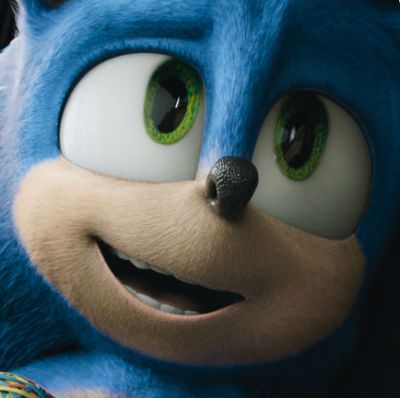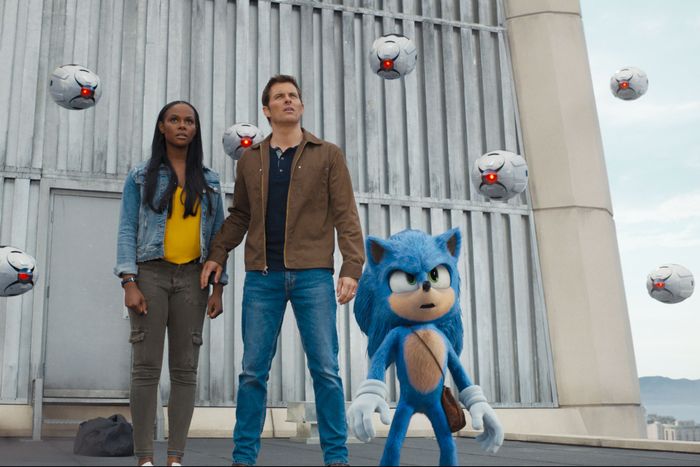
Upon the film’s first trailer drop in April, online outcry toward Paramount Pictures’ live-action adaptation of Sonic the Hedgehog was immediate and unequivocal — nearly uniform in its meme-ified damnation. Among the cris de coeur against the CGI Sega character: that Sonic was “creepy” and “upsetting,” that his eyes were too un-conjoined, his features too dissimilar to those of his video-game counterpart. And singled out for most withering critique: that the blue blur’s teeth were “too big” and “terrifyingly human.”
As evidenced by recent pushback against Cats’ Uncanny Valley–straining VFX extremes and the de-aging technology that failed to mask the old-man ricketiness of Robert De Niro and Al Pacino in The Irishman, hell hath no fury like a fan displeased with a movie’s visual effects. To wit: When it came to Sonic, Paramount took drastic measures to redress audience expectations, pushing the film’s release back by nearly a year and giving the go-ahead to an expensive, soup-to-nuts retrofitting of the character’s biodynamics in a bid to silence those who saw the trailer as a “200 mph slap in the face.”
“It was pretty clear on the day the trailer was released, just seeing the feedback and hearing the feedback, that fans were not happy where we were at,” Sonic director Jeff Fowler said in an interview this week with GamesRadar+. (Paramount declined to make Fowler or any of the movie’s effects experts available to speak with Vulture.)
So where did Sonic go wrong in so many of the ways that last year’s Warner Bros. adaptation of the Pokémon spinoff Detective Pikachu didn’t? And how did Paramount go about reconsidering its character’s conspicuous imperfections? In keeping with a kind of FX omerta that surrounds this kind of emergency post-production overhaul, Hollywood’s major effects studios Digital Domain (which worked on “previz” for Sonic), Industrial Light & Magic, and Weta Workshop also declined our interview requests (with ILM specifically refusing to “speculate or compare productions”).
As the spiny speed demon blasts toward a box-office debut that prerelease tracking estimates predict will fall in the $41–47 million range domestically — respectable numbers for a PG-13 film with a reported $95 million production budget — here is a timeline of the intention, dysfunction, and dental downsizing that brought Sonic to the brink of oblivion and back.
June 2014
Sony and Fast and Furious franchise producer Neal Moritz announce they will team with Sega subsidiary Marza Animation Planet to mount a computer-animated/live-action hybrid of the Japanese video-game giant’s second-most iconic — read: non-Mario — intellectual property. With Sonic having sold 140 million games and grossed more than $1 billion by that point, the studio lays out its objective to “capture everything that fans know and love” about the character while also “growing his audience wider than ever before.”
February 2016
Sega chief executive Hajime Satomi reveals the adaptation will hit theaters in 2018.
October 2016
Deadpool director Tim Miller boards the family-friendly project — which will reportedly follow Sonic and “friends such as Tails and Knuckles, who run around collecting items and points as they attempt to foil the global domination plans of Doctor Eggman Robotnik” — as executive producer. And Fowler, a 2005 Best Short Film Oscar nominee for writing and directing the anthropomorphic animal romp Gopher Broke, is installed as director.
October 2017
After Sony puts the film in “turnaround” (Hollywood jargon for when a studio decides not to pour any more money into a project and accepts a tax loss), Paramount swoops in to acquire Sonic’s distribution rights as part of its new first-look deal with Moritz. It’s a shaky bet given the box-office track record of such video-game-adapted super flops as Super Mario Bros., Prince of Persia: Sands of Time, and Street Fighter: The Legend of Chun-Li.
February 2018
Sega and Paramount release a joint statement that the film is now destined for theaters November 15, 2019.
Summer 2018
In May, James Marsden and Jim Carrey join the film’s non-animated cast with the latter portraying Sonic’s chief antagonist, Dr. Robotnik (Parks and Recreation co-star Ben Schwartz provides the attitudinal hedgehog’s voice). Filming begins in and around Vancouver, Canada, the next month. In August, Paramount announces that Sonic’s release date has been pushed up by a week to November 8, 2019.
December 2018
The first Sonic poster is revealed (well, not exactly revealed revealed — the woodland dervish is shown in silhouette) along with some elucidation by the movie’s creative quorum about how the character’s new iteration was partially inspired by Seth MacFarlane’s cocaine-sniffing CGI teddy bear in Ted. Sonic 2.0, meanwhile, swaps out the video-game character’s seemingly single floating eyeball with dual corneas for more ostensibly human, articulated orbs and gives him fur because … real animals. “I don’t think Sega was entirely happy with the eye decision, but these sort of things you go, ‘It’s going to look weird if we don’t do this,’” Miller tells IGN, adding: “For me, it’s always about keeping it grounded and keeping it realistic.”
Reaction within the gaming world is decidedly unsupportive. “The first Sonic the Hedgehog live action movie poster is creepy as hell,” blares a headline on PC Gamer.
March 2019
Over the intervening year-plus, additional work-in-progress posters for the film leak, leading to an initial wave of Schadenfreude-driven memes. But when Sonic’s studio-sanctioned, non-teaser poster appears on the movie’s official Twitter feed, fans freak out — a major complaint being that this weirdly swole, hairy-leg-having, Puma sneaker–wearing Sonic “does not resemble a hedgehog in the slightest.”
No less than former Sonic video-game lead programmer Yuji Naka takes to social media to register his displeasure with the poetic license taken over the character’s transition to movie form. “I feel like, with this Sonic here, visually, the important thing to look at is the head and body ratio and the roundness of the abdomen,” he says, according to a translation by Kotaku. “I wonder if they couldn’t have balance them a little better.”
April 2019
Set to the tune of Coolio’s “Gangsta’s Paradise,” the first Sonic trailer is unveiled at the Las Vegas Cinemacon on April 4 and surfaces online late that month to a tsunami of negative buzz to the tune of 18.6 million views in its first two days and hundreds of thousands of YouTube “dislikes.” The gaming website Kotaku inveighs against the movie as “a blight upon this weary earth” while Twitter explodes with consternation over the character’s distressingly humanoid-like teeth.
Wired delivers a kind of coup de grace with the observation: “Everything that Detective Pikachu seems to be doing right in bringing a beloved video game franchise with a cartoonish aesthetic to life, Sonic seems to be doing wrong.”
May 2019
Fowler responds to the outcry on Twitter with an admirably Clintonian “I feel your pain” ownership of the production’s FX missteps to date, and a pledge to placate fan expectations. “The message is loud and clear … you aren’t happy with the design & you want changes,” the director writes. “It’s going to happen.”
Artist Tyson Hesse — an old Sega hand who has worked on Sonic-branded video games, comics, and animated shorts — is brought on to spearhead the character’s extreme makeover. In the clearest indication of the seriousness with which the studio has processed escalating fan toxicity, Paramount pushes Sonic’s release date to February 14, 2020 to “make Sonic just right,” according to another Fowler tweet.
November 2019
A second trailer is unleashed online, prompting what can only be described as a radical turnaround. The character’s bigger eyes and fewer, smaller teeth are greeted by outpourings of joy. “Sonic just looks smaller and cuter, just like you’d expect from a CGI version of the Japanese video game star,” opines the Verge. Even Naka walks back some of his early trailer criticism, although he stops well short of an unqualified endorsement of Sonic’s movie upgrades. “The design is more Sonic-like now that he’s wearing gloves,” the designer says on Twitter. “However, his eyes still aren’t joined together, as expected. I can’t help but feel weird about that one point. But I’m looking forward to the movie’s release.”
The trailer reportedly receives the highest like-to-dislike Google ratio of any official studio trailer released within the last three years; Paramount quietly removes the first Sonic trailer from its website.
February 2020
As the Sonic review embargoes lift, Movie Twitter registers its 69 percent freshness rating on Rotten Tomatoes with a collective shock. People “actually” kinda like the movie, including Vulture’s own Bilge Ebiri!
Looking back in an interview with USA Today, Fowler says, “I would not wish this experience necessarily on anyone, even though, at the end of the day, I really love that we engaged the fan base.” He notes that rumors “we had to redo the whole movie” were false and even points to the possibility of a sequel.
“There are so many more great characters to bring into the story if we’re able,” Fowler adds. “Nothing would bring me more happiness than getting another shot.”







